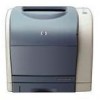HP 2500 HP PCL/PJL reference - Printer Job Language Technical Reference Manual - Page 220
response should be sent to the currently active I/O interface.
 |
View all HP 2500 manuals
Add to My Manuals
Save this manual to your list of manuals |
Page 220 highlights
device to properly route since the unsolicited status response may be received by the printer sharing box hours after sending the data from the host computer to the printer that enabled unsolicited status. Manufacturers of printer sharing devices can choose from the following options to solve this printer-to-host data routing problem. 1 A printer sharing device that is a uni-directional device and does not support printer-to-host data transfer. Applications need to be designed to work with uni-directional printer sharing devices. 2 A printer sharing device that examines the data received from the printer and only forwards solicited responses to the host computer. A printer sharing device can track which of its I/O interfaces is currently sending data to the printer, and thus know which I/O interface to use when sending solicited printer responses. When the printer sharing device sends data to the printer from a different I/O interface, the printer sharing device must know to the exact byte boundary what printer response data should be sent to the previous I/O interface and what data should be sent to the current I/O interface. Before the printer sharing device sends the printer data from a different I/O interface than the source of the current print job, the printer sharing device can inject a PJL ECHO command. All solicited printer responses received before the PJL ECHO response should be sent to the previously active I/O interface. All solicited printer responses received after the PJL ECHO response should be sent to the currently active I/O interface. The printer sharing device should consume the PJL ECHO response which was a result of the PJL ECHO command injected by the printer sharing device. Applications that use unsolicited PJL device, job, page, or timed status need to work properly with printer sharing devices that do not support unsolicited printer-to-host responses. 3 A printer sharing device that can route solicited responses as described in 2 above, plus send all unsolicited responses to all attached host computers. Applications must be designed to properly ignore unexpected printer status readback responses. Ideas on how to design an application to ignore unexpected printer status readback responses are described in the next section. 11-26 Programming Tips for Using PJL EN















